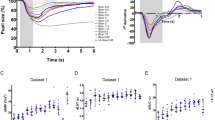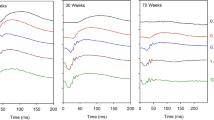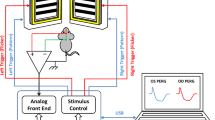Abstract
THE surprising fact that during regeneration of rhodopsin in the dark after sufficient light adaptation the electroretinogram does not begin to increase in size until some 50 per cent rhodopsin has been regenerated was originally demonstrated in cats and frogs1. Fig. 1 (open circles) shows that also in light-adapted man (three cases) there is an initial phase of very slow recovery of the b-wave of the electroretinogram in the dark, followed by a faster rise. On the suspicion that the initial delayed recovery might be due to a general suppression of rod-action on the part of the cones the experiment was repeated with a cone-blind woman. Her electroretinogram (Fig. 1, filled circles), indeed, showed Ho initial period of delay but began to rise immediately, as does regeneration of rhodopsin. It was 3 min. before the controls showed any response at all.
Similar content being viewed by others
Article PDF
References
Granit, R., Munsterhjelm, A., and Zewi, M., J. Physiol., 96, 31 (1939).
Rushton, W. A. H., Campbell, F. W., Hagins, W. A., and Brindley, G. S., Optica Acta, 1, 183 (1955).
Author information
Authors and Affiliations
Rights and permissions
About this article
Cite this article
ELENIUS, V., HECK, J. Relation of Size of Electroretinogram to Rhodopsin Concentration in Normal Human Beings and one Totally Colour Blind. Nature 180, 810 (1957). https://doi.org/10.1038/180810a0
Issue Date:
DOI: https://doi.org/10.1038/180810a0
This article is cited by
-
Experimentally induced variations in the dark adaptation functions of a severe strabismic amblyope
Documenta Ophthalmologica (1976)
-
Chemistry of Visual Adaptation in the Rat
Nature (1960)
-
Der photopische Dominator im Flimmer-ERG der Katze
Pfl�gers Archiv f�r die Gesamte Physiologie des Menschen und der Tiere (1958)
Comments
By submitting a comment you agree to abide by our Terms and Community Guidelines. If you find something abusive or that does not comply with our terms or guidelines please flag it as inappropriate.



